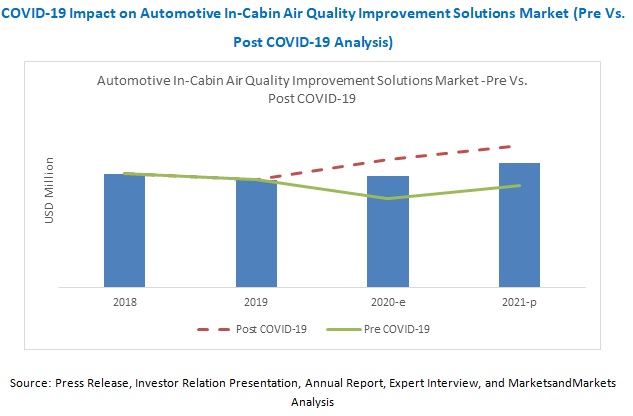The report “COVID-19 Impact on Automotive In-Cabin Air Quality Improvement Solutions Market by Product Type (integrated HVAC system, air purifier/ionizer, ozone generators, Cloud-based Air Quality Monitoring System), Vehicle and Countries – Global Forecast to 2021″ Post COVID-19, the Automotive In-Cabin Air Quality Improvement Solutions Market size is projected to reach USD 1,218 million by 2021, from USD 1,083 million in 2020, at a CAGR of 12.5%.
The major factors driving the growth of the Automotive In-Cabin Air Quality Improvement Solutions Market include increasing demand for HEPA and activated carbon cabin filters from HVAC system manufacturers and OEM adoption of mask level cabin air filtration systems.
Some of the major players in the Automotive In-Cabin Air Quality Improvement Solutions Market are Bosch (Germany), Denso (Japan), Valeo (France), MAHLE (Germany), Marelli (Italy), MANN+HUMMEL (Germany), Eberspächer (Germany) among others.
Download PDF Brochure @ https://www.marketsandmarkets.com/pdfdownloadNew.asp?id=30204275
Post pandemic demand for superior cabin air filters, cabin air filtration systems, and sterilization devices
Post pandemic, the demand for virus and bacteria protection inside the cabin will be more prevalent in the passenger car segment. OEMs and tier 1 manufacturers are working closely to develop products/systems that can sterilize the cabin air. Shanghai Automotive Industry Corp (SAIC) unveiled two new products based on deep ultraviolet (DUV) technology, which can be installed inside the vehicle. The first product, developed by Sanden Huayu Automotive Air-Conditioning, is a DUV device that can be installed inside an air conditioning system to filter and prevent viruses and bacteria from entering the cabin. The second product, developed by Yanfeng, can be fitted on the roof to sterilize and disinfect the cabin. These products will be equipped in the upcoming vehicles from SAIC Motors. Another Chinese OEM, WM Motor, planned to upgrade its cabin air filtration system to add UVC cabin cleaning function. Lincoln introduced its Aviator SUV with fully integrated interior air monitoring and air cleansing systems in China. According to the OEM, the system features a PM 2.5 laser sensor to monitor the air quality inside the cabin and engages the filters to clean the cabin air. More such adoption form major OEMs would fuel the demand for multi-layer HEPA and electrostatic cabin air filters. In addition, rising environmental pollution in urban areas and health concerns would also encourage vehicle owners to opt for premium cabin air filters. Cabin air filters are meant to be replaced after 10,000 km. However, consumers usually replace with cheaper aftermarket alternatives. Post the pandemic, consumer awareness towards a healthy car environment would surge the demand for superior cabin air filters in the aftermarket as well.
Higher penetration of multi-layer cabin filters with additional functionality
The ongoing innovations and OEM initiatives are likely to drive the demand for multi-layer cabin filters. Major Chinese OEMs already launched vehicles with mask level cabin air filtration. All future vehicles from major Chinese OEMs will have these features as an option. Cabin filters manufacturers are also quick to launch and upgrade their products with multi-layer anti-microbial and anti-bacterial capabilities. Manufacturers such as MANN-HUMMEL, Valeo, MAHLE all offers multi-layer cabin air filters with a virus, bacteria, and allergen protection. MANN+HUMMEL offers FreciousPlus cabin air filters that block PM 2.5 particles. The manufacturer developed a multi-layer cabin filter with additional biofunctional coating along with particle filter layer and premium activated carbon layer. The biofunctional layer is made of polyphenols and has an antiallergenic and antimicrobial effect to protect occupants from allergens, bacteria, and mold fungi. MANN+HUMMEL claims that its FreciousPlus cabin filters help people breathe easily who are suffering from allergies. These manufacturers are working closely with HVAC system manufacturers and OEMs to offer complete HVAC systems with built-in N95 certified multi-layer cabin filters. Due to the pandemic, more consumers especially people with allergies would adopt vehicles with cabin sterilization capabilities. Vehicles with such a filtration system would surge the penetration of premium cabin air filters in upcoming years.
Request for Sample Pages @ https://www.marketsandmarkets.com/requestsampleNew.asp?id=30204275
The US is expected to hold the largest market
The North American automotive industry especially the US, is one of the most lucrative market for automakers. However, the automotive industry in the US is going through a dire situation due to the outbreak. Major automakers such as Ford, GM, Toyota suspended production in the North American region including the US. Few of them are enforced to extend the suspension due to increased infections in the country. However, the dominance of light commercial vehicles in the country will be a major growth driver for the in-cabin air quality improvement solutions market. OEMs are increasingly incorporating cabin comfort features in pickup trucks to provide a similar experience as passenger cars. The US is one of the worst-hit countries among others due to the COVID-19 outbreak. Post pandemic, heath and medical awareness towards healthier in-cabin features would fuel the demand for in-cabin air quality improvement solutions in the country. The US will hold the largest share in the automotive in-cabin air-quality improvement solutions market. The growth in the US will primarily depend upon how quickly the production resumes and vehicle sales recovers.
Browse Related Report:
Automotive Filters Market by Type (Air, Fuel, Oil, Cabin, Coolant, Brake Dust, Oil Separator, Transmission, Steering, Dryer Cartridge, EMI/EMC, Coolant Air Particle), Air & Cabin Filter Media, Fuel & Vehicle Type, Aftermarket – Global Forecast to 2025



